Gas cylinder cabinet: cylinder storage requirements + cabinet selection and installation tips
Since the creation and further development of the gas industry, its main focus has been full gas supply to all residents of the country. Therefore, the construction of gas pipelines is carried out in order to provide gas to the maximum number of consumers.
And although the gasification process has been going on for more than a decade, there is still no centralized gas supply in remote settlements on the outskirts of the country, as well as in small summer cottages and the suburbs. That is why many owners of gas equipment have to use gas cylinders. But how to store them correctly and is it necessary to buy a cabinet for gas cylinders?
This is what we will talk about in our article - we will consider the most pressing issues on the safe content of gas cylinders at home, the requirements of the law and optimal solutions for the use of special cabinets.
The content of the article:
The procedure for storing gas cylinders
Providing convenience and comfort in the home, gas, however, is especially dangerous. Cases are not uncommon gas explosion and balloons through the fault of users. Therefore, the operation of household gas cylinders should be carried out in accordance with safety requirements.
In the legislation of the Russian Federation, the procedure for transportation, storage and safe operation is regulated by a number of regulatory acts. So,PP RF N 410 dated May 14, 2013 concerns safety measures in the use and maintenance of gas equipment. By its provisions, it regulates the use of gas in household cylinders and obliges to use only serviceable cylinders that have not expired.
Moreover, the state, timely repair and maintenance of tanks with liquefied household gas are required to monitor the owners themselves, without interfering with the scheduled maintenance by representatives gas company.
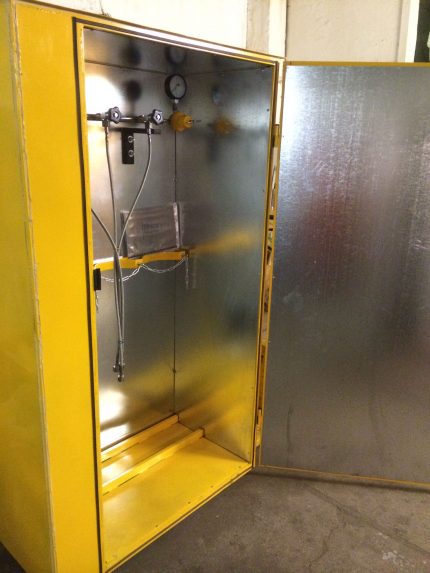
Rules of operation, maintenance, repair and gas station spelled out in Decree No. 91 dated June 11, 2003.
It is also indicated here that the standard service life of pressure vessels, which include liquefied gas cylinders, is determined by the manufacturer. And after the expiration of the life of such a cylinder is prohibited to use.
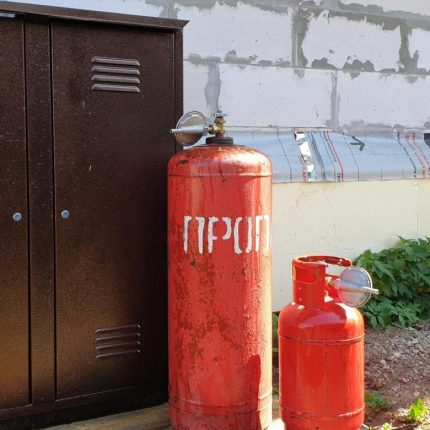
The legislation also provides for the storage of gas cylinders. Requirements of Article 92 PP RF N 390 dated April 25, 2012, “On the fire-fighting regime” states: cylinders for household gas appliances with a volume of more than 5 liters should be located in cabinets of non-combustible materials near the blank wall wall.
Therefore, a cylinder cabinet is a mandatory attribute that must be implemented in accordance with article 93 of this regulation.
Device and cabinet installation
As mentioned above, the use of cabinets for storing gas cylinders is a prerequisite for their operation in accordance with the law of the Russian Federation.
The main criteria that all cabinets for gas cylinders must meet:
- be made of non-combustible materials (both the case and all components);
- lock up;
- have special blinds for ventilation;
- have warning labels on the surface “Flammable. Gas".
Due to its properties, non-combustible materials used to make the cabinet not only do not ignite, they also do not smolder and do not allow the fire to spread. Thus, they form a high fire safety at the risk of fire or explosion.

Reliable material, from the point of view of fire safety, is considered to be metal. It is from it that special cabinets are made - storage for gas cylinders. They are designed taking into account all the necessary conditions for connecting a gas cylinder.
Cylinder Cabinet Design
Any metal cabinet for household gas cylinders consists of the following components:
- outer casingmade of steel sheets with a thickness of at least 1 mm;
- door - single or double leaf;
- inner cylinder tray - it can be solid or made in the form of a lattice;
- stationary fixture for a cylinder - a special mount, which is located inside the cabinet and serves to securely hold the balloon inside;
- holes on the back for gas hoses;
- ventilation holes - regardless of the integral inner pallet or made in the form of a lattice;
- metal handles and latches on the cabinet doors;
- fastenings for the possibility of hanging a padlock.
It is important that the handles and latches on the doors must also be made of fireproof material. The manufacture of plastic latch handles is not allowed.
Often, cabinets are made in one piece, but there are options in the form of an assembled design. The cabinet is completely covered with polymer paint (epoxy-polyester paint, which is most often called powder paint). It is fire resistant and keeps the cabinet from corrosion.
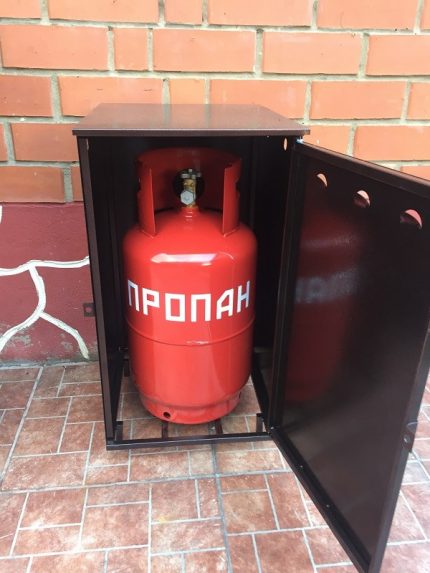
Where can I place a cabinet with cylinders?
It is strongly not recommended to install gas cylinders in storage facilities.
The law does not prohibit, in a pinch, putting a balloon, connected to the stove or other gas-using equipment, in the kitchen, subject to two conditions:
- ceiling height must be at least 2.2 meters;
- the presence of a window for ventilation.
It is important when using a gas bottle in the kitchen not to redevelop the room, in particular to combine the kitchen with the balcony, removing the doors and windows. This is prohibited by law.
General rules for the operation of gas cylinders in the premises:
- cylinder volume up to 5 l;
- distance from the stove (place with open flame) not less than half a meter-meter and not less than a meter from heaters;
- should not be installed near the window;
- distance from the front door at least 10 cm;
- the wall should not be made of combustible materials;
- free access to gas hose attachment points should be provided.
When installing a cabinet for a gas cylinder on the street, stationary products are selected that can be securely fixed to one of the walls of the building. In internal non-residential premises (extensions) portable cabinets are usually used.
General rules for installing cabinets for storing household gas cylinders:
- the side of the house is selected with the priority of least exposure to sunlight;
- the side to which the cabinet is adjacent must be made of non-combustible materials;
- at least 5 meters from the entrance to the house or the descent into the basement;
- the presence of a foundation of at least 10 centimeters;
- free access to gas hose attachment points.
It is important that when installing in the annexes or on the street, a grounding must be provided, which will eliminate the possible occurrence of static voltage.

According to Art. 91 PP RF N 390 is not allowed storage of gas cylinders:
- in living rooms and premises;
- in the basement and basement;
- in rooms without natural light.
It should be provided that the place where the cabinet is installed is not through. This will reduce the risk of any mechanical damage to the cabinet surface.
For installation, a set of fasteners is used, which ensures the cabinet is coupled to the surface and guarantees stability during use.
Cabinet recommendations
The choice of cabinet depends on the volume of the gas bottle. Depending on the purpose of use for domestic gas, 5 liter, 12 liter, 27 liter, 40 liter cylinders are used. and 50 l.
If the gas will be used only for cooking, small-size options are suitable. If gas is still needed for autonomous heating, then it is worth paying attention to large volumes.
Also, the size of the cabinet depends on the number of cylinders. Often use several cylinders with gas: the main and spare. This is convenient in winter, when the gas supply of the main cylinder is running out, and you only need to switch the gas supply to the reserve cylinder. There is a joint arrangement of cylinders in the cabinet, and separated by a partition.
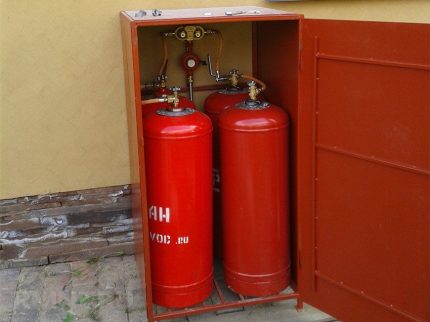
When choosing, it is also useful to evaluate the dimensions of the building in which the cabinet will be installed. After its installation, free space should remain for comfortable movement of the owner.
Do-it-yourself cabinet
The cost of cabinets for gas cylinders starts from 2500 rubles.If you have certain skills and observe a number of rules, you can make and assemble a similar product with your own hands.
Algorithm of actions before starting work:
- determine the type of construction of the future cabinet, calculate the number of gas containers included in it;
- execute a drawing with the definition of cabinet parameters - height, width, depth;
- select the necessary material - high-quality steel.
It is worth paying attention to careful preparation for work, it is on this that the further correct execution of the cabinet for a gas cylinder depends.
The algorithm for direct assembly of the cabinet:
- assembly of the frame from metal corners;
- creating a pallet for cylinders;
- sheathing of the frame with metal sheets;
- making holes for the hose in the back or side of the cabinet;
- making holes for ventilation with a diameter of 1 cm with a distance between them of 7-8 cm - the number of holes on one side is at least 16;
- the implementation of fasteners for cylinders - it is allowed to fasten the cylinders with a chain, while the chain bows must be tightly tensioned;
- installation of door hinges and structures for padlocks.
When assembling the cabinet, you can use the welding machine, having the appropriate skills welding work.
If the cabinet is planned to be used inside the building, then it is necessary to consider the presence of legs with a height of at least 10 cm.
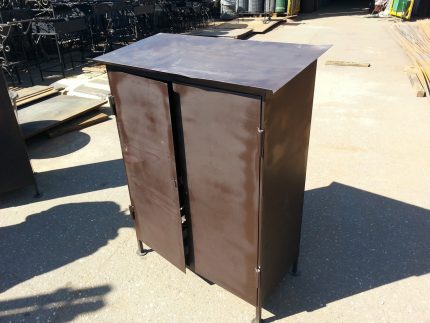
The final stage is the coating of the entire structure with polymer paint. After complete drying, it remains to install the cabinet in the selected place and securely fasten.
Conclusions and useful video on the topic
For a visual representation of the cabinets for gas cylinders and the order of its assembly, it is worth watching the video material presented below.
This video shows how to properly install and use the gas cylinder cabinet:
This video shows the self-assembly of the cabinet for a gas cylinder:
Regardless of the purpose for which the gas bottle is used, safety must always be considered. That is why the presence of metal cabinets is considered a prerequisite that will prevent ultraviolet radiation from entering the cylinders, their mechanical damage and protect against the effects of an explosion.
Do you want to supplement the above material with useful information and recommendations for the storage and operation of domestic gas cylinders? Or do you still have questions that we did not address in this article? Ask them to our experts and other site visitors in the comments section.

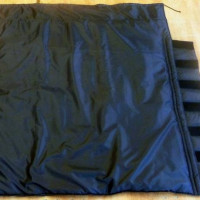 How does a thermal blanket work for gas cylinders: features of the device and use + selection tips
How does a thermal blanket work for gas cylinders: features of the device and use + selection tips 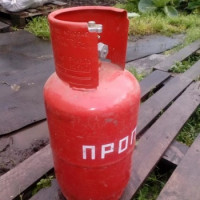 Refueling household gas cylinders: rules for filling, servicing and storing cylinders
Refueling household gas cylinders: rules for filling, servicing and storing cylinders 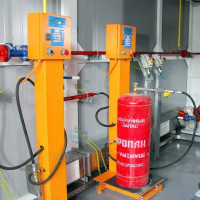 Filling rules for household gas cylinders at gas stations: safety standards and requirements
Filling rules for household gas cylinders at gas stations: safety standards and requirements 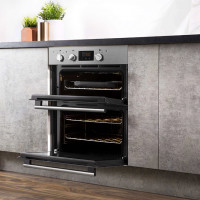 Installing a gas oven: safety standards and requirements for connecting a gas oven
Installing a gas oven: safety standards and requirements for connecting a gas oven 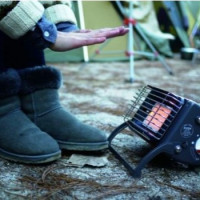 Rating of gas stoves for a tent: dozens of the best burners and heaters + tips for choosing
Rating of gas stoves for a tent: dozens of the best burners and heaters + tips for choosing 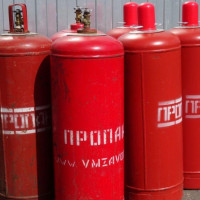 Characteristics of typical 50 liter gas cylinders: design, dimensions and weight of the cylinder
Characteristics of typical 50 liter gas cylinders: design, dimensions and weight of the cylinder  How much does it cost to connect gas to a private house: the price of organizing gas supply
How much does it cost to connect gas to a private house: the price of organizing gas supply  The best washing machines with dryer: model rating and customer tips
The best washing machines with dryer: model rating and customer tips  What is the color temperature of light and the nuances of choosing the temperature of the lamps to suit your needs
What is the color temperature of light and the nuances of choosing the temperature of the lamps to suit your needs  Replacement of a geyser in an apartment: replacement paperwork + basic norms and requirements
Replacement of a geyser in an apartment: replacement paperwork + basic norms and requirements